Picture this: You’ve spent a few minutes browsing a website. As you look around, you get more and more excited about the possibility of buying the product or service. Then you click through to the pricing page… and suddenly doubt whether you should go through with it. You click away, and don’t come back.
We’re willing to bet that all of you have experienced this at some point.
And your customers have, too. Once customers are sold on the value of your product to them, their next step is to visit the pricing page. And if the price scares them away, you may never see them again.
Let’s be clear. Your pricing landing page has one job: to get visitors to take action, and buy your product or service or sign up for your free trial.
So, if your pricing page sucks, you’ll lose a lot of potential revenue. In contrast, a well-optimized pricing page will make visitors want to buy, even if your product or service costs a bit more than they expected.
How do you ensure that you get more sales from your pricing page? In this guide, we’ll share some pricing page best practices for creating high-converting pages that boost your revenue.
Here’s a table of contents so you can jump straight to the pricing page examples that interest you most.
Let’s get started …
- Simplify the Design
- Make the Copy Easy to Understand
- Address the FUDs
- Highlight the Benefits
- Use Urgency and FOMO
- Build Trust
- Make the CTA Visible
- Match Plans to Buyer Personas
- Banish Analysis Paralysis
- Help Visitors to Compare
- Anchor Your Prices
- Highlight the Best Option
- Match Plan Names to Feature Sets
- Use Charm Pricing
- Offer a Free Trial
- Offer an Annual Payment Plan
- Convert Currencies
- Support the Sale with Live Chat
- Use Exit-Intent®
- Test Your Pricing Page
1. Simplify the Design
When it comes to designing any web page, simplicity is the best approach. That’s why one of our most important pricing page best practices is to keep the page simple.
One way to simplify your own pricing page is to remove all unnecessary page elements, like top navigation and sidebars, so there’s only one main area to focus on. For example, Groove’s pricing page is ultra-simple with a single box to draw visitors’ attention:
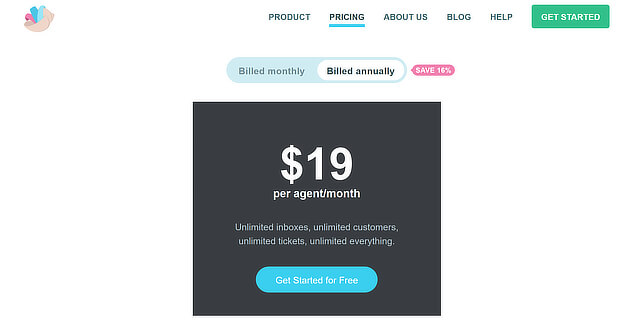
If your site is built with WordPress, you’re in luck, because many themes include landing page templates that remove navigation and sidebars. You can also check out this WPBeginner list of the best WordPress landing page plugins.
Next, let’s look at some tips related to pricing page copy:
2. Make the Copy Easy to Understand
Simplicity also wins with pricing page copy. The SaaS DNA project found that ease of understanding is crucial for visitors, so the best pricing pages for SaaS companies are often the simplest.
They recommend that you make pricing page copy crystal clear, so visitors know the benefits they’re getting, and the price they’ll have to pay.
We get it; it’s tempting to put as much information as possible on the pricing page to help make the sale.
But this can work against you. When people visit your page, they’re already thinking about buying, so just give them the information they need:
- What your product offers
- What it costs
- What’s included in each plan
More than that can be overwhelming and make them think twice about buying.
If you feel the need to add more copy, then make sure it comes after all the information listed above. That’s how we do it on the OptinMonster pricing page.
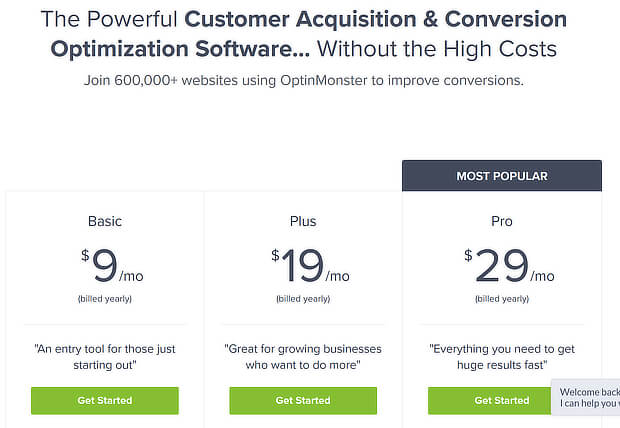
Follow our tips for creating high-converting sales pages for help with pricing page copy.
3. Address the FUDs
FUDs are fears, uncertainties and doubts. They’re the factors that can keep visitors from buying, unless you deal with them on your pricing page.
One way to handle potential objections is to be upfront and answer the questions that visitors have. You can do this on-page via an FAQs section. For example, here’s how the MonsterInsights pricing page handles it:
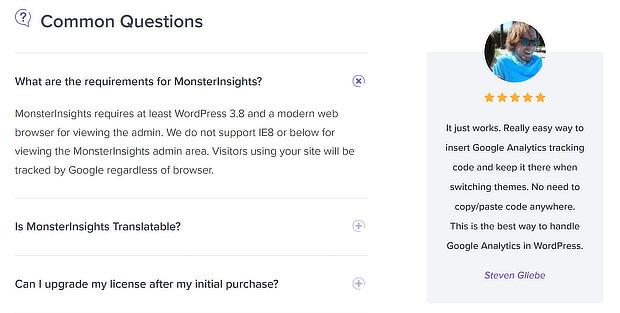
To do this, check with your customer service and support departments to find the most frequent questions, then write answers and include them on your pricing page.
One things visitors worry about is what happens if they buy your product or service, then find they don’t like it. Highlighting a money-back guarantee for digital products (like the one on our pricing page, shown below), or user-friendly returns policy, for physical products, can help allay this fear.

4. Highlight the Benefits
When visitors reach your pricing page, they’re asking “what’s in it for me?” Your page copy and pricing tables have to deliver by focusing on their bottom line, rather than yours.
MailChimp’s pricing page is a great example. It gives a brief description of what users get at each plan level and how it helps them achieve their goals. And the plan names also match their buyer personas, which we’ll look at in a later tip.
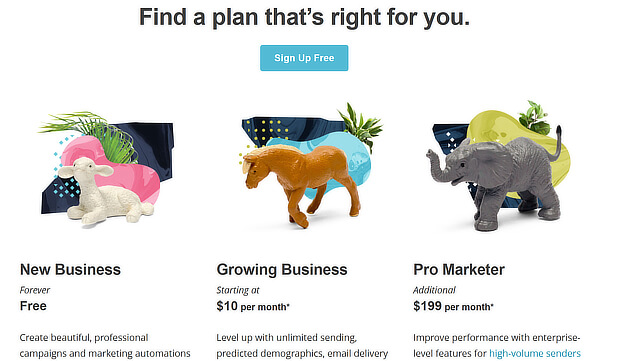
5. Use Urgency and FOMO
There’s no doubt about it; human beings are hardwired to act on urgent situations. And the fear of missing out (FOMO) takes this to another level. Use FOMO marketing and urgency messages on your pricing page and you give visitors more reasons to take your offer.
You can trigger FOMO by:
- Using numbers to show how many other people are benefiting from your product or service
- Offering an additional reward when visitors make a quick decision
- Showcasing stock levels or availability
You can show urgency by:
- Including time-based and scarcity language in your copy
- Using the right colors to get attention for your offer
- Creating an exclusive urgency
And you can combine both tactics with a time-limited offer, like a sale on your pricing plans. When you use OptinMonster, you can do this easily with a countdown timer, making your visitors eager to take action.
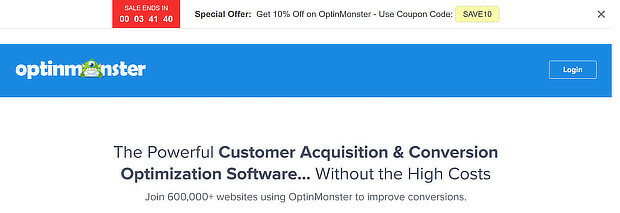
6. Build Trust
One thing pricing pages that convert have in common is that they build trust with visitors. It’s an essential part of marketing. The only thing is: it matters how you do it.
As an ethical marketer, you’ll want to let customers know there’s a fallback plan if they don’t like your product or service. But it turns out that too many warnings can work against you by turning visitors off before they even choose a plan.
Instead, put your trust builders naturally on the page. These include:
- Trust seals that show their data is secure
- A money-back or other guarantee
- Social proof, in the form of testimonials
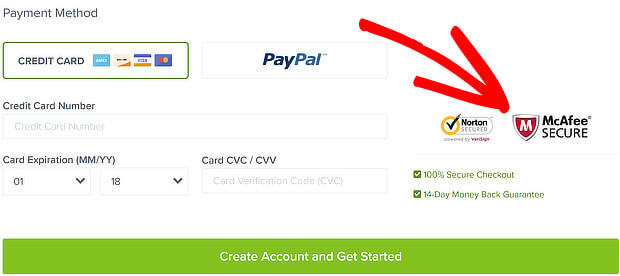
Check out our article on collecting customer feedback to get some testimonials you can use.
7. Make the CTA Visible
As we said earlier, some people are ready to buy the minute they land on your pricing page. Make it easy by placing the call to action (CTA) in a highly visible location.
In other words, don’t bury it underneath the pricing table; put it near the top where they can see it immediately, like Vimeo does.
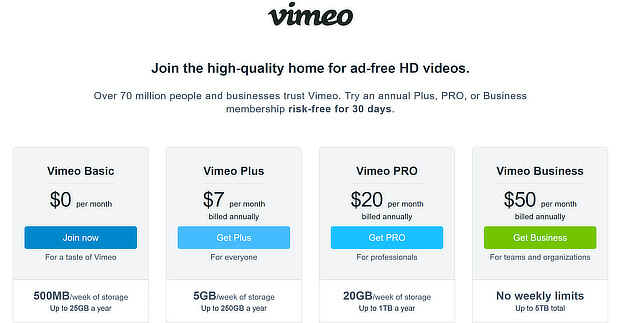
You can always have another CTA further down for people who need more information, and a third for those who want to read the testimonials and FAQs first. A good CTA will:
- Make it clear what action visitors have to take (or what benefit they will get)
- Use action words
- Minimize the risk of taking action
Get some more tips in our guide to creating the perfect call to action.
8. Match Plans to Buyer Personas
Buyer personas are an essential part of any marketing strategy. That’s because they help you relate to your visitors like real people by outlining their key characteristics and interests.
Ideally, your buyer persona will include information about:
- Age, gender, and education level
- Other demographic information like income
- Job role
- Sources of information
- The key challenge that your product or service can solve
When you understand your audience, you’ll be able create plans and packages that really meet their needs.
Start implementing this tip by creating your buyer personas.
Now, let’s look at some tips related to the plans themselves:
9. Banish Analysis Paralysis
Analysis paralysis is exactly what it sounds like: spending so much time considering options that you find it hard to make a decision. That can happen to visitors when your pricing page has lots of copy, which we mentioned earlier, or a lot of options, which we’ll get to in a while.
You can also reduce analysis paralysis by structuring your page so that your visitors don’t get overwhelmed. In the best examples, pricing page headlines appear near the top, with minimal copy and an early call to action. Other information appears lower down the page.
Another way to reduce analysis paralysis is to get visitors to commit to a small action first. That can be as simple as clicking a button to show they’re interested in your product demo or free trial.
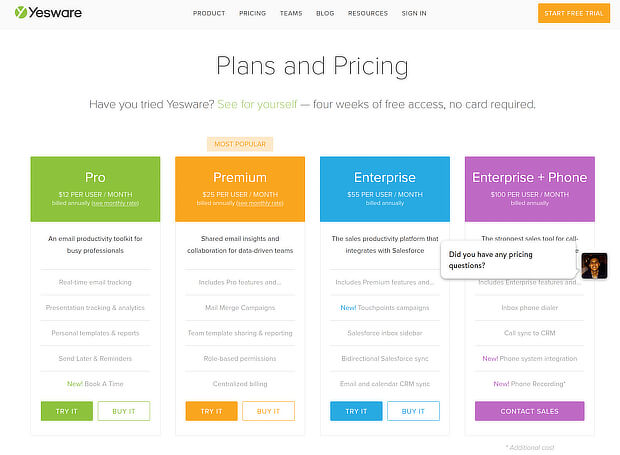
Thanks to the Zeigarnik Effect, that means they’re more likely to complete it. You can do this with OptinMonster’s Yes/No Forms, which create a 2-step optin process. AtHoc used these forms to increase sales qualified leads by 141%.
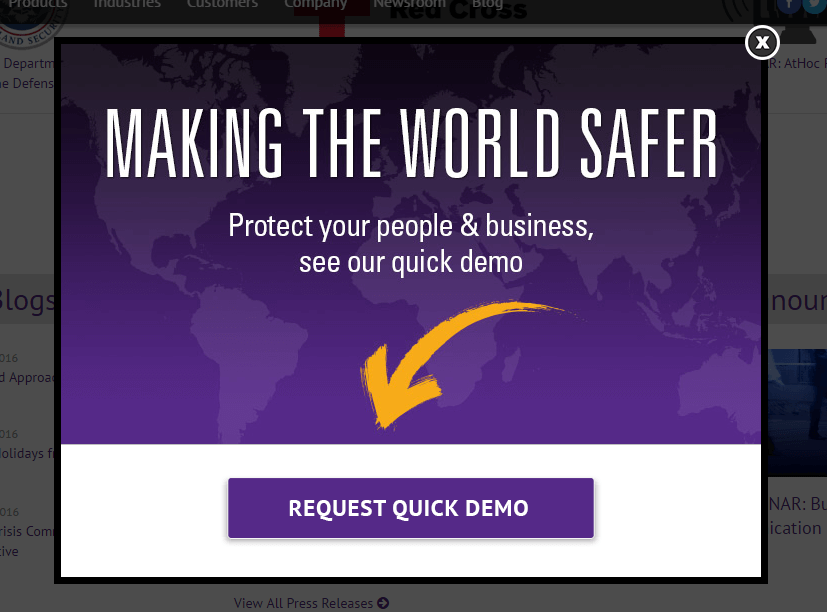
Check out these creative ways to use yes/no forms in your marketing for more inspiration.
10. Help Visitors to Compare
A key tip for subscription plan page design is to make it easy for visitors to compare what’s on offer. This is related to the advice given above about making the page easy to understand.
One way to achieve this is to communicate the differences among the various plans on offer. For example, you might list a bunch of features in your entry-level plan, then, instead of listing them again for other plans, focus on the new stuff people get. You can see that in action on the Disqus site.
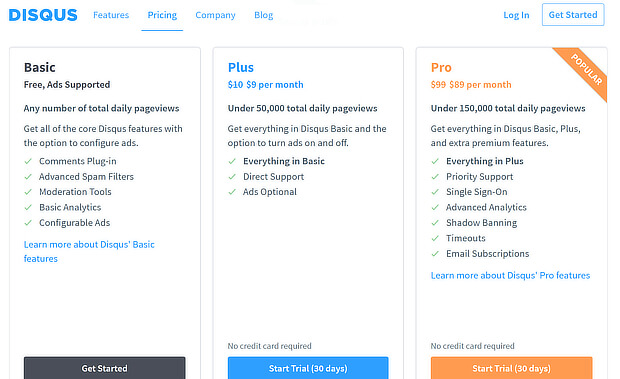
Or you can make the comparison even easier by focusing on one core metric that’s important to them. For example, Mention highlights three areas their users will care about in boxes at the top of its pricing page, so they can compare plans before scrolling down for more detail.
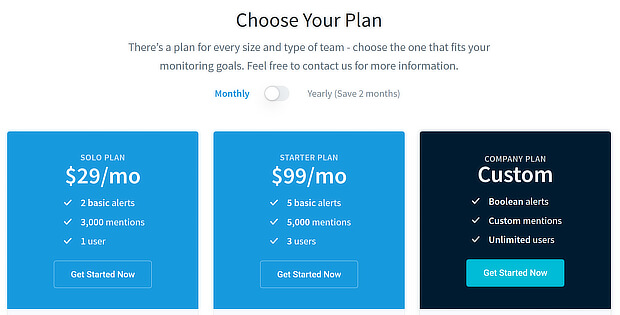
11. Anchor Your Prices
You know one of the most common marketing tactics used in every industry? Price anchoring. It’s about showing people a high price first so when you display a lower (but still high) price, they won’t run screaming for the hills.
According to psychology, most people tend to accept the first piece of information they see (the anchor) as the basis for judging and making decisions on other information.
So a key pricing page best practice is to have one package priced higher than the others – and make it visible – so that all other packages seem reasonable.
Some even recommend showing your plans from most to least expensive, as Convert does below:
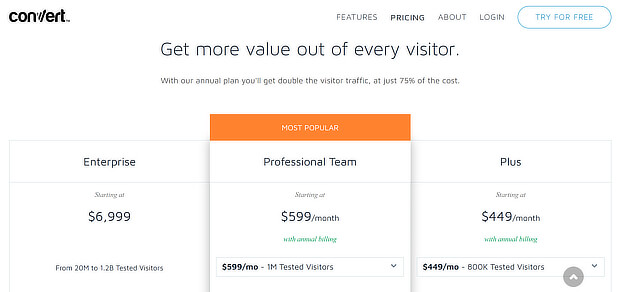
Research shows that this keeps people on the page longer. However, an analysis by Process.st showed that most companies don’t do that. In fact, 81% of SaaS companies order their pricing pages from lowest to highest. You’ll have to test (see our last tip) to see what works best for you.
12. Highlight the Best Option
If there’s a package you really want your visitors to buy, use design to make it stand out on the page. You can do that by:
- Giving it a different color header
- Using a different color for the whole column
- Making it pop out of the page with a box
- Using an additional CTA
For example, WPForms highlights its most popular package with an additional border, and uses price anchoring, too.
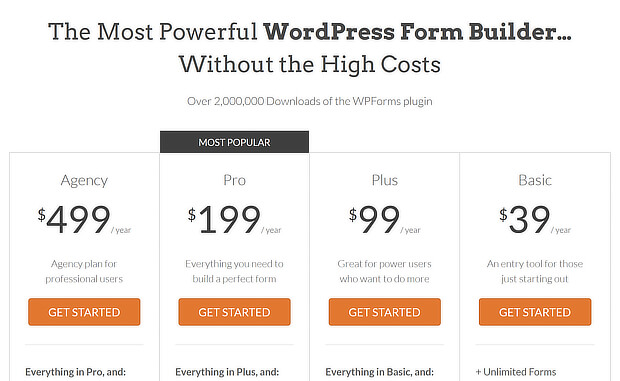
13. Match Plan Names to Feature Sets
One of the key pricing page best practices is to ensure that customers know what they’re getting. You can do that by focusing on the customers’ stage or growth or a particular outcome they’ll be able to achieve. For example, as we saw earlier, MailChimp’s plans are New Business, Growing Business, and Pro Marketer, with appropriate images.
Some companies play it straight, but you can also have some fun with the plan names, and show some of your brand’s personality, like Freshdesk does.
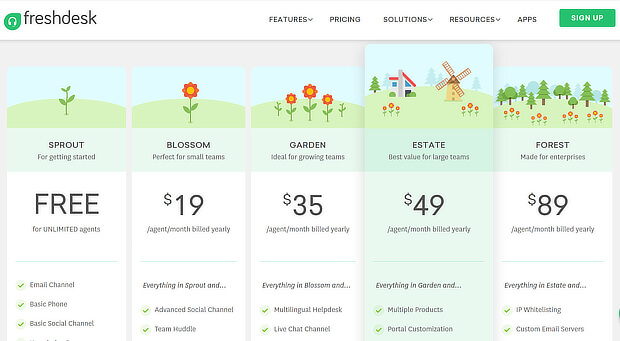
It’ll help your visitors to remember the plans, too.
14. Use Charm Pricing
Charm pricing, also known as psychological pricing, is about the power of prices ending in the number 9. Most studies, though not all, show that this type of pricing significantly outperforms round numbers. In fact, a recent Gumroad study shows that in some cases conversions double.
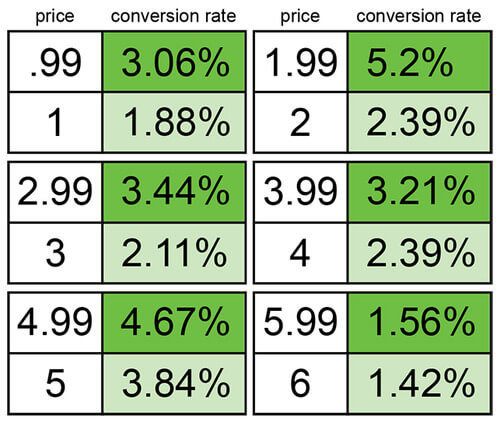
Of course, round numbers have their place, too, especially if the decision is likely to be driven by emotion. But for logical decisions, 9’s definitely a charm!
Try testing 2 versions of your pricing page with and without charm pricing and see if it works for you.
15. Offer a Free Trial
There’s no doubt about it; free trial marketing increases sales. In its 2016 SaaS Metrics report, Totango found that 16% of companies get more than half their business this way. In addition, 62% of companies get at least 10% of their business from free trials.
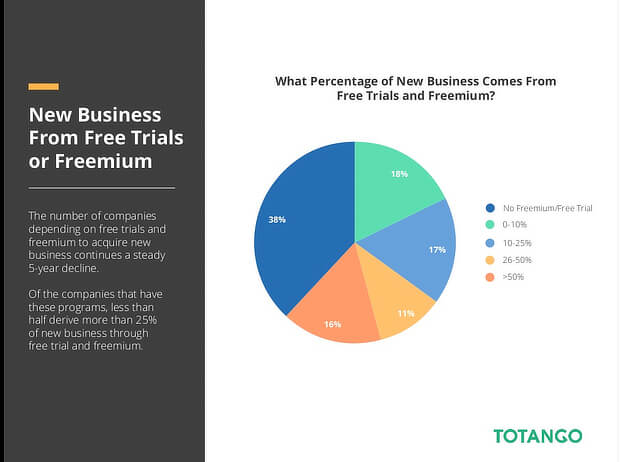
One reason this works is because of the endowment effect. This means that once someone’s owned something, they value it more, and don’t want it taken away. That’s exactly what a free trial offers.
So it makes sense to try this strategy and see if it works for you. Then use our tips on free to paid conversion strategies to turn those free trials into sales and ongoing business.
16. Offer an Annual Payment Plan
Having users pay up front for a period of time is good for your revenue. The trick is to make it good for customers, too. One way to do that is to discount the annual plan so there’s an incentive for visitors to take this option. GoToMeeting uses this strategy for its plans.
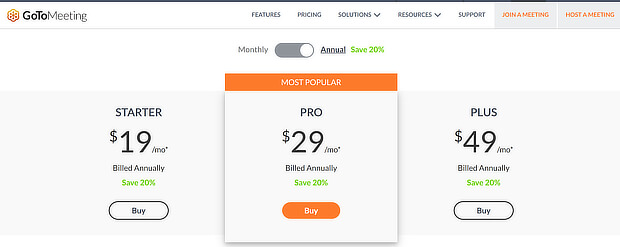
You can also use some of the tips given earlier to make the annual plan stand out so it’s more appealing to your visitors.
But, whether you follow this tip or not, always test (see our last tip) to see if this works for you.
17. Convert Currencies
For online shoppers, the world is their market, but that doesn’t mean they’re happy to spend in every currency. In fact, most online shoppers prefer to see prices displayed in their local currency, so they know exactly what they’re going to pay.
Your options for this are to manually price products for different versions of your website, or to have this happen automatically via an app. For example, if you’re using Shopify, you can use a currency conversion app that’ll do the hard work for you.
18. Support the Sale with Live Chat
Using live chat is a great way to support visitors and turn them into customers. The research shows that 38% of people became customers because they had the opportunity to ask pre-sales questions.
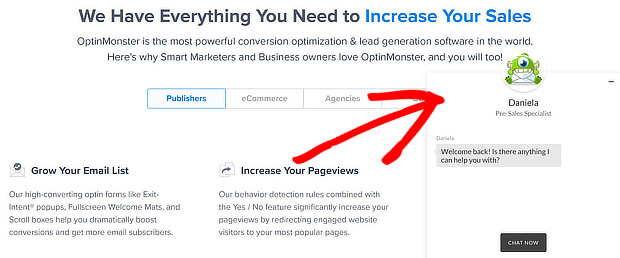
Live chat will help you figure out some of the pre-sales objections so you can address those in your marketing, and reassure customers that they are making the right decision.
Use this list of live chat solutions from WPBeginner as a starting point for implementing this on your own pricing page.
19. Use Exit-Intent®
One great way to convert visitors on any page, including your pricing page, is to present them with an offer they can’t refuse just before they leave your site.
You can easily do this with OptinMonster’s Exit-Intent® Technology. This detects when visitors are about to leave and shows the offer at just the right time. OptinMonster customers have used Exit-Intent® to increase sales by 10%and recover 21% of abandoned carts.
20. Test Your Pricing Page
Testing is an essential component of any good marketing strategy. It’s what helps you make decisions based on data and not guesswork.
That’s why one of the most important pricing page best practices is to test. Test your page layout, your pricing, your copy, your headline, your call to action – everything you can test. For help with this, read our guide to split testing.
That’s it! Now you know the pricing page best practices that’ll help you make more sales, check out our other guides to boosting eCommerce revenue and attracting more leads. And follow us on Twitter and Facebook for more in-depth guides and tutorials.


No comments:
Post a Comment